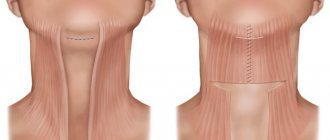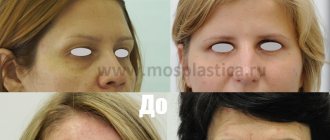Indications Contraindications Preparation Types of operations Recovery
Many patients turn to a plastic surgeon when they need frontal surgery of the forehead or brow ridges. This term refers to a whole range of different intervention methods used by plastic surgeons to change the shape and eliminate various cosmetic defects in the brow ridge or frontal area. Forehead reduction surgery allows you to correct facial asymmetry and increase the projection of the frontal tuberosities.
Indications for forehead and eyebrow plastic surgery
The key indication for frontoplasty is the patient’s desire; if he is not satisfied with the appearance of the forehead and face as a whole, this brings him psychological discomfort and creates complexes. Indications for intervention:
- the presence of asymmetry of the forehead in relation to the rest of the face;
- deformations in the forehead, undesirable defects of bone structures;
- very large or too low forehead;
- post-traumatic or congenital defects in the area of the frontal bone.
In addition to performing forehead frontoplasty, the doctor can also correct soft tissues, eliminating wrinkles, which gives a rejuvenating effect.
Who is suitable for forehead lift?
It is not entirely true that you should start thinking about a forehead lift after reaching a certain age. Each organism lives according to its own biological clock - for some, the aging process begins earlier, for others later. Therefore, the indication for surgery should not be the numbers in the passport, but the condition of the upper part of the face.
The basis for a forehead and eyebrow lift may be:
- the presence of small and deep wrinkles on the forehead;
- deep eyebrow folds;
- drooping corners of the eyes, “crow’s feet” around the eyes;
- drooping of the outer ends of the eyebrows;
- eyebrow asymmetry;
- overhanging tissue of the subeyebrow;
- low forehead line.
Any plastic surgery has a number of contraindications. So, a waiver from the operation can be:
- cardiovascular diseases;
- malignant formations;
- bleeding disorders;
- diabetes;
- infections;
- pregnancy and lactation.
The key to every successful operation lies in the patient’s confidence in the professional skill and aesthetically similar views of the plastic surgeon. The multidisciplinary clinic “MedicCity” employs attentive and highly professional doctors. Visit our plastic surgeon for a consultation and see for yourself!
Contraindications to forehead reduction and plastic surgery
Before performing frontoplasty, a full examination and consultation with a plastic surgeon is necessary to exclude possible contraindications. This is important to avoid complications and irreversible changes after the intervention. Thus, the operation is not performed if:
- this is a patient under 18 years of age;
- there are chronic diseases in the stage of exacerbation or decompensation;
- HIV infection or oncology is detected;
- Frontal sinusitis (inflammation of the frontal sinus) was detected.
If the development of the facial skeleton is not yet complete, there are skin problems in the operation area, serious illnesses have worsened, there are signs of ARVI or general malaise; during pregnancy and lactation, the operation will be temporarily postponed.
How much does frontoplasty cost?
The difference in prices for this type of intervention is quite large. The cost of frontoplasty is set individually in each case and depends on the complexity of the intervention. In addition, prices vary depending on the reputation of the clinic and the qualifications of the doctor, the equipment and instruments used.
Of course, an inexperienced doctor in a “seedy” clinic will not be able to perform a complex surgical intervention without consequences, so you should not save on your health.
Below are the prices that you should focus on when planning your “operating” budget:
- Ukraine – 33,000 hryvnia;
- Russia - 100,000 rubles.
Preparation
After consultation to determine the price of frontal surgery of the forehead or brow ridges, preoperative preparation is necessary. In addition to all tests, consultations with a therapist, ENT doctor and anesthesiologist, it is necessary to perform radiographs in lateral and direct projections. They help the surgeon evaluate the shape of the sinuses, their true size, the thickness of the bony septa and the location of the anatomical structures.
The peculiarities of frontoplasty are that the doctor has clear anatomical points, works in the intervention area without affecting the circulatory areas and nerves, which helps to recover faster. Access along the area of hair growth helps to hide the future scar, and detachments of deep layers of tissue mask swelling and possible hematomas.
Possible complications and consequences
Immediately after surgery, the following complications are possible:
- severe pain;
- bleeding;
- swelling and hematomas;
- wound infection;
- blood clot formation;
- loss of sensation in the operated area.
In the future, quite unpleasant consequences are possible:
- pronounced scars;
- tissue necrosis;
- dissatisfaction with the result of the procedure;
- impaired muscle activity in the operated area;
- psychological problems (patients “do not recognize” themselves in the mirror);
- pigmentation;
- hair loss.
As you can see, taking into account possible complications, the operation cannot be considered safe.
Types of operations to correct the shape of the forehead
You can reduce your forehead using plastic surgery through several options for operations and interventions.
Hairline transfer
This is one of the simplest forehead surgery procedures. The doctor excises a strip of skin along the hair growth area, thereby reducing the height of the forehead area or correcting bald patches. It is possible to excise a small fragment in the scalp, moving the hairline a little higher. During surgery, the doctor can adjust the soft tissue by raising the eyebrow area, thereby visually increasing the size of the forehead.
Working with bone structures
With this type of intervention, operations can be performed to reduce the size of the forehead or increase it. If this is an increase in size, implantation is used to build up the bone; if it decreases, a partial osteotomy or bone grinding is performed. This manipulation will be quite enough for a slight correction of the forehead or a change in its relief. If it is necessary to significantly change the volume of bone tissue or adjust the relief, osteotomy will be used, crushing bones with the assembly of a new forehead shape. At the same time as working on the bone part, the doctor also corrects the soft tissues, including the hairline.
How does it go?
As with any such surgery, to reduce any area, you will need to either move individual bones or remove some parts of them. As for the required expansion of the area, it occurs through one’s own tissues or through the use of silicone implants.
Plastic surgery on the forehead is performed in two versions. In the first case, the frontal bone is “transferred” slightly back. In the second, the frontal bone, on the contrary, is pushed forward. In this case, the surgeon does not touch the intracranial part of the head. If the frontal bone needs to be pushed forward, the doctor will use an implant.
It is important that during this procedure the specialist focuses not only on the center of the forehead, but on the entire face. It is necessary to take into account the jawline, the location of the nose and cheekbones in order to create uniform proportions.
Recovery after surgery
Immediately after completion of the plastic surgery, a rehabilitation period begins with the patient’s gradual recovery. The duration depends on the type of intervention and the volume of structures affected. On average, complete recovery takes up to 3-4 months, which depends on the features of forehead surgery - reduction or increase of bone tissue, work with soft tissues.
During the rehabilitation period, swelling and a feeling of heaviness occur above the eyes, which disappear within two weeks after the intervention.
Pain in the intervention sites is typical for 3-5 days after plastic surgery, which is eliminated with analgesics.
It is acceptable to reduce the sensitivity of those areas where the intervention was performed. It disappears within a couple of months. If you follow the doctor's recommendations and all preventive measures, you can return to your normal lifestyle after 2-3 weeks.
Recovery period
The rehabilitation period will take about a month. It is better to take a vacation at this time.
It is recommended to sleep on high pillows for two weeks after surgery, refrain from combing your hair and washing your hair for the first 2-3 days, then use baby shampoos and combs with soft bristles.
To avoid blood clots, you need to drink a lot of still water and move (healthy walking is recommended, avoid heavy physical activity).
You should not stay in one position (sitting or lying) for a long time, or scratch the skin on your forehead in case of itching. It is also recommended to reduce emotional stress.
The first results can be assessed in a month (swelling has almost subsided and hematomas have resolved), and the final results can be assessed in 3-4 months (when the stitches have finally healed and the scars have become as invisible as possible).
Reviews
Since not many people decide to undergo frontoplasty, there are few real reviews about it. However, those patients who have undergone this intervention recommend resorting to it only in extreme cases - in the presence of serious defects and asymmetry. After all, for the sake of “dubious” beauty, they had to endure all the hardships of the rehabilitation period and eventually face such problems as scars, hair loss, drooping eyelids and swelling.
Since frontoplasty has many side effects, clinic clients believe that it is better to hide the imperfect shape of the forehead under bangs or correct it using makeup techniques.
Was the article helpful?
What is an endoscopic brow lift?
An endoscopic brow lift, or forehead lift, is a surgery that can eliminate drooping eyelids and facial expressions of worry or anger caused by vertical wrinkles between the eyebrows. During this operation, which is equally common among men and women aged 35 to 70, the surgeon tightens the skin and underlying tissue of the upper third of the face upward, and sometimes removes part of the muscle that causes wrinkles between the eyebrows to appear between the eyebrows. As a result, the patient looks rejuvenated and rested.
Endoscopic lifting of the upper third of the face opens the eyes and creates the effect of blepharoplasty of the upper eyelids (but without stitches!). Surgeon: Iskornev A.A.
The height of girls' eyebrows should correspond to the distance from the inner to the outer level of the eye. For men, eyebrows can be slightly lower than this calculation, but not fall over the eyelids. Performed by surgeon: Andrey Iskornev.
Endoscopic forehead lift, check lifting. The operation was performed by Iskornev A.A.
Endoscopic forehead lift, thread lift with remodeling of the middle and lower third of the face according to A. Iskornev’s method, lip lipofilling.
Endoscopic forehead lift to harmonize the face. In the after photo (on the right) the lifting of the inner parts of the eyebrows is noticeable, the general sagging of the forehead has gone away.
For the purpose of minimally invasive correction of the oval of the face, modeling was performed using V-lock threads (2 threads). Surgeon: Iskornev A.A.
Do I need a brow lift?
If you are concerned about drooping eyebrows that make your face look tired or sad, deep horizontal wrinkles on the forehead, or frown lines between the eyebrows, an endoscopic brow lift can correct all of these imperfections. To quickly understand what results you can expect, do a short test yourself. Place your fingers at the outer third of the eyebrow and gently lift the skin upward. This way you will understand how much the operation can change your appearance. However, to determine if this method is right for you, it is best to discuss the procedure in detail with your plastic surgeon.
What risks are associated with the operation?
Thousands of men and women choose endoscopic brow lifting every year without encountering any complications. Although the operation rarely causes side effects, and when they do occur, they are mild, you should discuss possible complications in detail with your surgeon. Remember that you can reduce the risk of complications by following all the doctor’s recommendations both before and after surgery.
«I am a nurse, and therefore I understand the advantages of endoscopic surgery over traditional surgery, and I think that this is the best option available."
Maria, 42 years old











